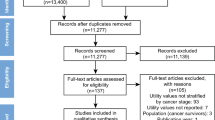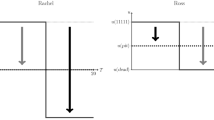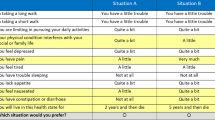Abstract
This article reviews economic evidence on health-dependent utility functions and presents new estimates of utility functions for cancer. Estimates of health-dependent utility functions have found that mild adverse health impacts can be treated as monetary equivalents. Severe health consequences also reduce utility levels but have an additional effect of altering the structure of utility functions by reducing the marginal utility of income. The implications of past studies are often misleading when they fail to account for income losses and medical expenses associated with serious ailments. This article’s estimates of the structure of utility functions for cancer indicate a substantially lower marginal utility of income at any given income level. This result is consistent with the welfare consequences of other severe health effects, which impose harms that are not tantamount to a monetary loss.

Similar content being viewed by others
Notes
The author is indebted to James K. Hammitt for the observation that respondents might have been seeking to equate the utility levels rather than the marginal utilities in the two health states.
Subjects who reached the tips of the iteration tree before indifference were assigned the values at that tip for which the results closely paralleled the estimates based on interval regressions that accounted for this aspect of the design.
Only 2.7% of respondents had top coded income values of $175,000. To adjust for the influence of top coding, the top coded income levels were multiplied by 1.5.
References
Ameriks, J., Briggs, J. S., Caplin, A., Shapiro, M. D., & Tonetti, C. (2017). Long-term care utility and late-in-life saving. NBER Working Paper No. 20973.
Brown, J. R., Goda, G. S., & McGarry, K. (2016). Heterogeneity in state-dependent utility: Evidence from strategic surveys. Economic Inquiry, 54(2), 847–861.
Crainich, D., & Eeckhoudt, L. (2017). Average willingness to pay for disease prevention with personalized health information. Journal of Risk and Uncertainty, 55(1), 29–39.
De Nardi, M., & Yang, F. (2014). Bequests and heterogeneity in retirement wealth. European Economic Review, 72, 182–196.
Evans, W. N., & Viscusi, W. K. (1991). Estimation of state-dependent utility functions using survey data. Review of Economics and Statistics, 73(1), 94–104.
Evans, W. N., & Viscusi, W. K. (1993). Income effects and the value of health. Journal of Human Resources, 28(3), 497–518.
Evans, W. N., & Viscusi, W. K. (1998). Estimation of revealed probabilities and utility functions for product safety decisions. Review of Economics and Statistics, 80(1), 28–33.
Finkelstein, A., Luttmer, E. F. P., & Notowidigdo, M. J. (2013). What good is wealth without health? The effect of health on the marginal utility of consumption. Journal of the European Economic Association, 11(S1), 221–258.
Gyrd-Hansen, D. (2017). A stated preference approach to assess whether health status impacts on marginal utility of consumption. Health Economics, 26(10), 1224–1233.
Hammitt, J. K., & Haninger, K. (2010). Valuing fatal risks to children and adults: Effects of disease, latency, and risk aversion. Journal of Risk and Uncertainty, 40(1), 57–83.
Hammitt, J. K., & Liu, J.-T. (2004). Effects of disease type and latency on the value of mortality risk. Journal of Risk and Uncertainty, 28(1), 73–95.
Kahneman, D. (2011). Thinking, fast and slow. New York: Farrar, Straus, and Giroux.
Kopczuk, W., & Lupton, J. P. (2007). To leave or not to leave: The distribution of bequest motives. The Review of Economic Studies, 74(1), 207–235.
Levy, M., & Rizansky Nir, A. (2012). The utility of health and wealth. Journal of Health Economics, 31(2), 379–392.
Lillard, L. A., & Weiss, Y. (1997). Uncertain health and survival: Effects on end-of-life consumption. Journal of Business and Economic Statistics, 15(2), 254–268.
Magat, W. A., Viscusi, W. K., & Huber, J. (1996). A reference lottery metric for valuing health. Management Science, 42(8), 1118–1130.
McDonald, R. L., Chilton, S. M., Jones-Lee, M. W., & Metcalf, H. R. T. (2016). Dread and latency impacts on a VSL for cancer risk reductions. Journal of Risk and Uncertainty, 52(2), 137–161.
Moore, M. J., & Viscusi, W. K. (1990). Models for estimating discount rates for long-term health risks using labor market data. Journal of Risk and Uncertainty, 3(4), 381–401.
Sloan, F. A., Viscusi, W. K., Chesson, H. W., Conover, C. J., & Whetten-Goldstein, K. (1998). Alternative approaches to valuing intangible health losses: The evidence for multiple sclerosis. Journal of Health Economics, 17(4), 475–497.
Smith, D. M., Langa, K. M., Kabeto, M. U., & Ubel, P. A. (2005). Health, wealth, and happiness: Financial resources buffer subjective well-being after the onset of a disability. Psychological Science, 16(9), 663–666.
Spence, M. (1977). Consumer misperceptions, product failure, and producer liability. Review of Economic Studies, 44(3), 561–572.
Tengstam, S. (2014). Disability and marginal utility of income: Evidence from hypothetical choices. Health Economics, 23(3), 268–282.
Van Houtven, G., Sullivan, M. B., & Dockins, C. (2008). Cancer premiums and latency effects: A risk tradeoff approach for valuing reductions in fatal cancer risks. Journal of Risk and Uncertainty, 36(2), 179–199.
Viscusi, W. K. (2018). Pricing lives: Guideposts for a safer society. Princeton: Princeton University Press.
Viscusi, W. K., & Evans, W. N. (1990). Utility functions that depend on health status: Estimates and economic implications. American Economic Review, 80(3), 353–374.
Viscusi, W. K., & Evans, W. N. (2006). Behavioral probabilities. Journal of Risk and Uncertainty, 32(1), 5–15.
Viscusi, W. K., & O’Connor, C. J. (1984). Adaptive responses to chemical labeling: Are workers Bayesian decision makers? American Economic Review, 74(5), 942–956.
Viscusi, W. K., Huber, J., & Bell, J. (2014). Assessing whether there is a cancer premium for the value of a statistical life. Health Economics, 23(4), 384–396.
Acknowledgements
The author is indebted to James K. Hammitt for extremely helpful comments. Rachel Dalafave and Scott Jeffrey provided excellent research assistance.
Author information
Authors and Affiliations
Corresponding author
Additional information
Publisher’s note
Springer Nature remains neutral with regard to jurisdictional claims in published maps and institutional affiliations.
Paper prepared for Vanderbilt-JRU Symposium, Risk Guideposts for a Safer Society
Rights and permissions
About this article
Cite this article
Viscusi, W.K. Utility functions for mild and severe health risks. J Risk Uncertain 58, 143–166 (2019). https://doi.org/10.1007/s11166-019-09301-9
Published:
Issue Date:
DOI: https://doi.org/10.1007/s11166-019-09301-9




